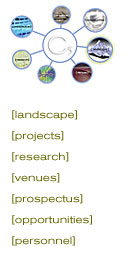2002 Whitney Biennial Exhibition
March 7 - May 26, 2002
1:1 was selected for presentation in the 2002 Whitney Biennial. The Whitney Museum of American Art presented
the work of 113 artists and collaborative teams in the 2002 Biennial Exhibition, the largest Biennial
since 1981.
The 1:1 project includes the creation, maintenance, and visualization of the
C5 IP database, containing the IP addresses to all hosts on the world wide web. The project uses the database
to create five interfaces for navigating the web and to generate a new topography of the web.
The Database
The database is the result of an ongoing interlaced search. An even sample of possible IP addresses is
examined simultaneously (rather than searching from the beginning of the numerical spectrum 0.0.0.0 of the
IP addressing system to the end 255.255.255.255). By zooming in on the numerical spectrum, i.e. repeatedly
performing the search on different samplings, all possible IP addresses will eventually have been tested for
inclusion in the database. The search will at that point start up again, so that new networks and hosts on
the web get included. Because of the interlaced nature of the search, the database could in itself at any
given point be considered a snap-shot or portrait of the web, revealing not a slice, but an image of the web
with increasing resolution.
Interfaces/Visualizations
The C5 IP database contains all hosts that respond to an http request. Hosts with limited or restricted
access, and without a front-end HTML document, are included. When navigating the web through the database,
one experiences a very different web than when navigating it with the "road maps" provided by search engines
and portals. Instead of advertisements, pornography, and pictures of people's pets, this web is an abundance
of non-accessible information, undeveloped sites, and cryptic messages intended for someone else. Search-engines
and portals show us a thin slice of the web, not the high resolution image we sometimes think they do. The
interfaces/visualizations are not maps of the web but are, in some sense, the web. They are super-realistic
and yet function in ways images could not function in any other environment or time. They are a new kind of
image of the web and they are a new kind of image.
The five interfaces
hierarchical: the web as directory structure
every: a complete mapping of all web servers in the database
petri: clusters of networks and navigational traces
random: randomly generated IP addresses from the database
excursion: provides access to the unsearched places of the web

![]()
